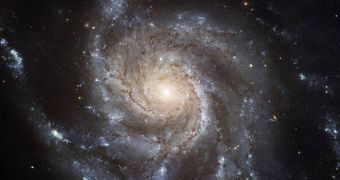Ever since astronomers started differentiating between spiral and elliptical galaxies, they have wondered what precisely makes some galaxies develop their trademark arms, while others remain without them. Our own galaxy, the Milky Way, is a spiral one, featuring two, or, according to new studies, four arms. A team of researchers is now proposing a new model on how these arms came to be, here and elsewhere in the Universe, based on mathematical calculations, ScienceNow reports.
At this point, the “mainstream” explanation for how spiral galaxies formed is based on an idea put forth more than 2,000 years ago, by Greek mathematician Ptolemy. He proposed that epicycles – little loops that planets perform in their orbit – is what makes them appear to wobble, and causes their irregular paths in the night skies. In the 1920s, the theory was revived, and used to explain some of the behavior exhibited by stars elsewhere in the Milky Way. At this point, it is also the main theory about how spiral arms form in galaxies, though little evidence exists to support it.
A team of two independent researchers – mathematician Charles Francis, from Hastings, the UK, and astronomer Erik Anderson, from Ashland, Oregon, the US – has recently compiled a new mathematical model of a large number of stars in the galaxy, and determined that epicycles have nothing to do with spiral arm formation. Francis was working on a problem that required him to analyze the motion of stars before the new study. He centralized data on more than 20,000 stars, collected from various astronomical sky surveys.
All of these stars had previously had their orbital velocities and positions accurately calculated. The British researcher then noted, much to his amazement, that there was nothing in the numbers to support the epicycle idea. Together with Anderson, he developed a new computer simulation of the velocity distribution among the analyzed stars. Within a hypothetical time frame of about 300 million years, the stars self-organized into spirals, the two report in the latest issue of the journal Proceedings of the Royal Society A.
Francis says that the spiral arm forming process relies directly on Newton's Laws of Physics, as stated more than 300 years ago. He adds that the idea was so mind-boggling in its simplicity that “I had rejected it before because I thought that if it were right, it would already be known. In fact, it worked straightaway, giving a perfect fit with the data.” The new study “comes up with an elegant way of explaining the velocity distribution we observe in the solar neighborhood,” concludes Rainer Klement, who is an astronomer at the Max Planck Institute for Astronomy, in Heidelberg, Germany.

 14 DAY TRIAL //
14 DAY TRIAL //